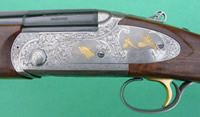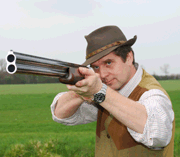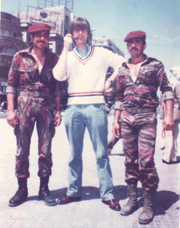Benelli Raffaello Crio 28 bore
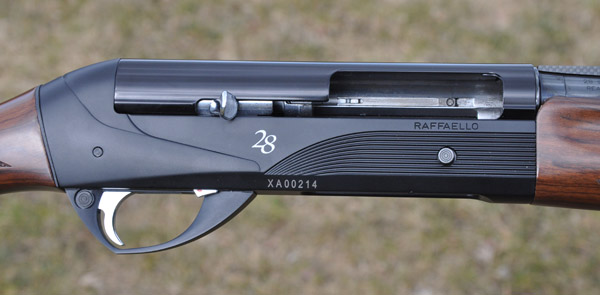
The Benelli Rafaello is a work of enginering genius. It’s no secret that I’m a sucker for a good semi-auto, I have always believed them to be much under-rated guns and others seem to be catching on now (my dealer mates tell me semi-automatics are accounting for an ever greater proportion of their mid-market sales these days). For the record, and because I can't resist a digression into firearms history, the first successful semi-automatic, was the Browning A5 which appeared about 1900. It was a so called ‘long-recoil’ gun where the barrel moved back several inches into the receiver on firing. Then short recoil shotguns appeared, and, inspired by the gas operated rifles of WWII, gas-operated shotguns soon arrived on the scene. The Remington 1100 set the standard, well engineered and soft-recoiling, and the baton was taken up by Beretta with their excellent 300 series guns (which regular readers will know I greatly admire).
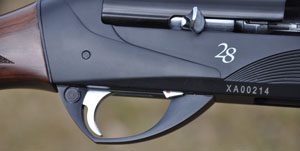 Most modern semi-automatics are gas operated like the Remy and Beretta, but one notable exception is the Benelli as tested here in small gauge form. The Benelli Raffaelo Crio has a most intriguing inertia action. It does not bleed off gas from holes in the barrel to work a piston running beneath it (as the majority of semis do), instead it operates in a rather unique manner (though it is not the only inertia gun . Between the main body of the bolt and a rotating bolt-head is a short, stiff, spring. On firing, this spring compress as the gun accelerates rearwards, it comes to full tension, the bolt-head unlocks, and bolt-head, spring and main bolt body move rearwards ejecting the cartridge. As the working parts go rearwards, they compress a spring which runs in a tube in the butt (this spring is repositioned in the new Benelli Vinci model within the receiver itself).
Most modern semi-automatics are gas operated like the Remy and Beretta, but one notable exception is the Benelli as tested here in small gauge form. The Benelli Raffaelo Crio has a most intriguing inertia action. It does not bleed off gas from holes in the barrel to work a piston running beneath it (as the majority of semis do), instead it operates in a rather unique manner (though it is not the only inertia gun . Between the main body of the bolt and a rotating bolt-head is a short, stiff, spring. On firing, this spring compress as the gun accelerates rearwards, it comes to full tension, the bolt-head unlocks, and bolt-head, spring and main bolt body move rearwards ejecting the cartridge. As the working parts go rearwards, they compress a spring which runs in a tube in the butt (this spring is repositioned in the new Benelli Vinci model within the receiver itself).
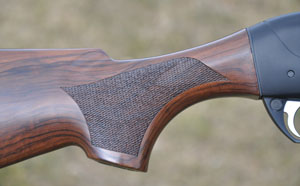 What about our test gun. It is a sweet little thing weighing but 5lb 3oz with its 26” barrel. It has a wooden stock and is available in no other form other than as tested. This is no bad thing, because it is a little corker. It cost (RRP) £1,825 which is not cheap, but the Remington 1100 28 bore semi (which I believe to be the only opposition) is just over 2K (it’s a delightful little gun too, though). I have given the game away on first impressions. The gun, though it has modern mechanics, has classical looks with a nicely proportioned, well figured, and exceptionally well finished stock. There is nothing gimmicky about it, and it is not over-styled. It gets my approval as a result.
What about our test gun. It is a sweet little thing weighing but 5lb 3oz with its 26” barrel. It has a wooden stock and is available in no other form other than as tested. This is no bad thing, because it is a little corker. It cost (RRP) £1,825 which is not cheap, but the Remington 1100 28 bore semi (which I believe to be the only opposition) is just over 2K (it’s a delightful little gun too, though). I have given the game away on first impressions. The gun, though it has modern mechanics, has classical looks with a nicely proportioned, well figured, and exceptionally well finished stock. There is nothing gimmicky about it, and it is not over-styled. It gets my approval as a result.
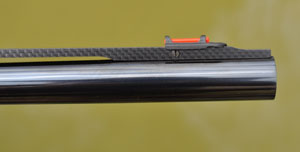 Apart from the action, the gun has several interesting features. The rib is made from carbon fibre – so, the barrel is really light – a real wand with a tiny centre bead and red fluorescent front sight (I am not especially fond of these very bright types). The stock is walnut and the figuring is pretty good. But, its applied by a technique Benelli call ‘Elegance System finish’ which not only enhances grain but makes the wood weatherproof too. It is appropriately named as the wood, as noted, looks very good when treated in this manner.
Apart from the action, the gun has several interesting features. The rib is made from carbon fibre – so, the barrel is really light – a real wand with a tiny centre bead and red fluorescent front sight (I am not especially fond of these very bright types). The stock is walnut and the figuring is pretty good. But, its applied by a technique Benelli call ‘Elegance System finish’ which not only enhances grain but makes the wood weatherproof too. It is appropriately named as the wood, as noted, looks very good when treated in this manner.
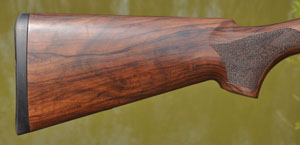 The barrels and chokes of the Benelli are all very well presented. Blacking is really good – a cut above the average seen today – the chokes are beautifully machined. The really interesting thing, though, is that both barrel and chokes have been subjected to cryogenic freezing – once touted as the way we would all live forever. Remember? The idea was that you were frozen at death and then might be defrost when advances in medical science might mean you could be revitalised in the manner of Frankenstein’s monster.
The barrels and chokes of the Benelli are all very well presented. Blacking is really good – a cut above the average seen today – the chokes are beautifully machined. The really interesting thing, though, is that both barrel and chokes have been subjected to cryogenic freezing – once touted as the way we would all live forever. Remember? The idea was that you were frozen at death and then might be defrost when advances in medical science might mean you could be revitalised in the manner of Frankenstein’s monster.
Well, the Benelli version is to subject barrel and chokes to minus 300 degree Fahrenheit temperatures. This effects the molecular structure of the metal, apparently, and, amongst other things, improves the surface finish making it slipperier. Plastic and lead are less likely to stick to the bore as a result. Will it make much difference in the real world? I have no idea yet, but give me a few years to test it!
 I have mentioned the operating system of the gun which has the advantage of relative simplicity. When you disassemble the Benelli Raffaello Crio you realise how brilliantly un-cluttered the design is. There is very little under the barrel when the forend is taken off. This gun is supremely easy to take apart and put back together again as a result. Probably the best semi auto that I have yet encountered in this respect.
I have mentioned the operating system of the gun which has the advantage of relative simplicity. When you disassemble the Benelli Raffaello Crio you realise how brilliantly un-cluttered the design is. There is very little under the barrel when the forend is taken off. This gun is supremely easy to take apart and put back together again as a result. Probably the best semi auto that I have yet encountered in this respect.
The receiver is made in two parts – a bottom section made of black anodised and attractively but sparsely decorated alloy, and a top part of near-tubular steel (some Benellis have a one part alloy receiver – the new Vinci has a completely different design where the lower receiver and forend are made from polymer and contained both trigger assembly and magazine tube).
Shooting Impressions
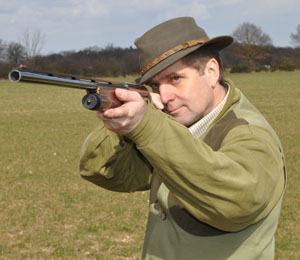 I had a really good time playing with this. It was lots of fun to shoot. Recoil was not especially light, but nor was it any great problem with 21 and 24 gram loads. Functioning was perfect. The trigger had a bit of creep. But, the handling qualities were super. The gun came to the shoulder effortlessly, and, unlike one of its stable mates I was recently testing, shot naturally to where one was looking. I put this down to the flat rib design which is always my preference. I am not going to pick. I liked this little gun a lot, it would be interesting to have a longer barrelled version though. The stock was only just over 14 3/8”, but that did not seem to be an issue, though my preference would be for something longer. This could be a good gun for a youngster (because of the reduced frontal weight), it would be great in a pigeon hide (if you can afford the cartridges), but, most of all, its reason for being is fun.
I had a really good time playing with this. It was lots of fun to shoot. Recoil was not especially light, but nor was it any great problem with 21 and 24 gram loads. Functioning was perfect. The trigger had a bit of creep. But, the handling qualities were super. The gun came to the shoulder effortlessly, and, unlike one of its stable mates I was recently testing, shot naturally to where one was looking. I put this down to the flat rib design which is always my preference. I am not going to pick. I liked this little gun a lot, it would be interesting to have a longer barrelled version though. The stock was only just over 14 3/8”, but that did not seem to be an issue, though my preference would be for something longer. This could be a good gun for a youngster (because of the reduced frontal weight), it would be great in a pigeon hide (if you can afford the cartridges), but, most of all, its reason for being is fun.
Tech Spec
Make: Benelli (now owned by Beretta)
Model: Benelli Raffaello Crio
Bore: 28
Chamber: 2 ¾” (70mm)
Rib: carbon fibre 7mm with centre bead
Weight: 5lbs 3oz.
RRP.£1,845





